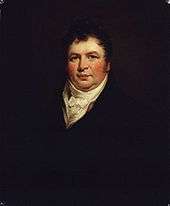Richard Phillips (publisher)

Sir Richard Phillips (13 December 1767 – 2 April 1840) was an English schoolteacher, author and publisher.
Life
Phillips was born in London. Following some political difficulties in Leicester where he was a schoolteacher and bookseller, he returned to London, established premises in Paternoster Row, St. Paul's Churchyard, and founded The Monthly Magazine in 1796;[1] its editor was Dr. John Aikin, and among its early contributors were fellow radicals William Godwin and Thomas Holcroft.[2] He built up a prominent fortune based on the speculative commission of newly revised textbooks and their publication, in a competitive market that had been freed by the House of Lords' decision in 1777 to strike down the perpetual copyright asserted by a small group of London booksellers to standard introductory works.[3] His Juvenile Library published in 1800–03 provided the steady returns of all successful children's books.[4] By 1807 he was in sufficient standing to serve as a Sheriff of London, at which time he was knighted on the occasion of presenting an address.[5]
Phillips overextended himself and was declared bankrupt in the Bank Panic. He died in Brighton and is buried in the western extension of St Nicholas' Churchyard.[6] He was a vegetarian.[7]
Works
He was the author, under his own name, of On the Powers and Duties of Juries, and on the Criminal Laws of England, 1811; A Morning's Walk from London to Kew, 1817; A Personal Tour Through the United Kingdom, 1828.
Many of his further works were published under at least five pseudonyms including David Blair. His own political leanings, evinced in Golden Rules of Social Philosophy, Or, A New System of Practical Ethics (1826) encouraged him to publish works by the radical jobbing writer of educational texts, Jeremiah Joyce, though often under pseudonymous disguises;[8] Rees and Britten asserted in their Reminiscences of Literary London that many works were written by Phillips and attributed to well-known writers, who oversaw the proofs and put their names to the manuscripts, for remuneration.[9] Joyce was the actual author of Gregory's Encyclopedia published by Phillips.
References
- ↑ John Issitt (1853). "Reminiscences of Literary London from 1779-1853". Thomas Rees and John Britton, London. p. 79ff. Archived from the original on 29 March 2009.
- ↑ Rees and Britten, p. 79f.
- ↑ Marina Frasca-Spada and Nicholas Jardine, Books and the Sciences in History (Cambridge University Press, 2000) "A Textbook revolution", p. 319.
- ↑ A Rauch, "Preparing “The rising generation”: Romanticism and Richard Phillips's Juvenile library 1800–1803" Nineteenth-Century Contexts, 1991.
- ↑ He published his Letter to the Livery of London, on the Office of Sheriff in 1808.
- ↑ Historic England. "Burial vaults and tomb in western part of St Nicholas' graveyard, Dyke Road (west side), Brighton (Grade II) (1380455)". National Heritage List for England. Retrieved 29 August 2013.
- ↑ International Vegetarian Union: Sir Richard Phillips
- ↑ J. R. Issitt, "Jeremiah Joyce: science educationist", Endeavour 26.3 (September 2002) pp 97-101.
- ↑ Rees and Britten, p. 80.